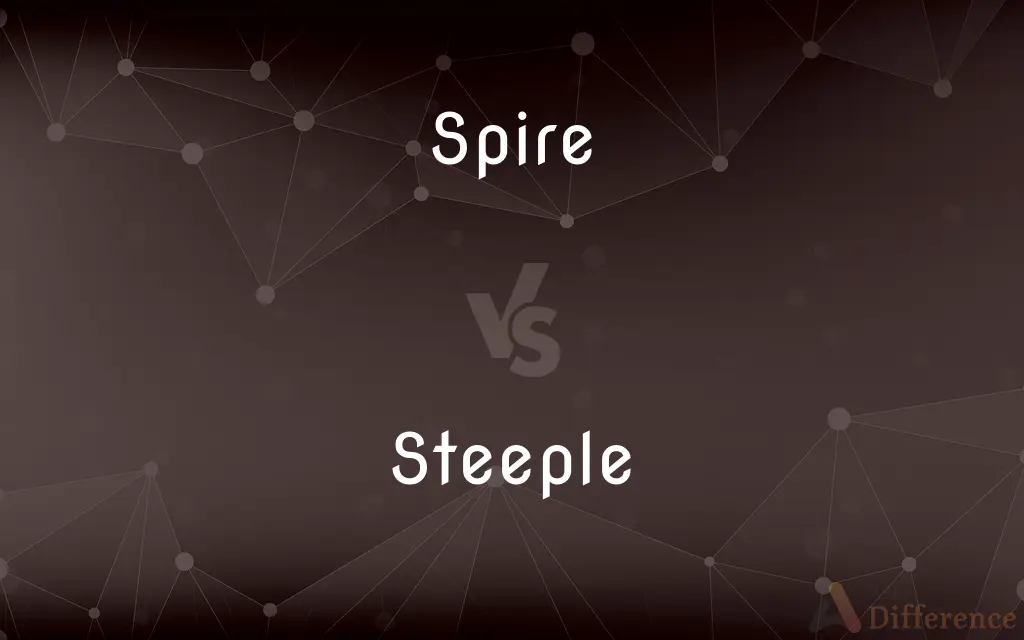Spire vs. Steeple — What's the Difference?
By Tayyaba Rehman — Updated on November 1, 2023
A spire is a tapering conical or pyramidal structure on a building top, while a steeple is a tower often on a church, usually capped with a spire.

Difference Between Spire and Steeple
Table of Contents
ADVERTISEMENT
Key Differences
A spire is an architectural element characterized by its tall, pointed, conical, or pyramidal shape atop a building. It is designed primarily as a decorative feature and can be found on secular buildings as well as religious structures. A steeple, however, is more specifically a tower or structure on a church building, often surmounted by a spire. It typically includes the building's bell tower and may serve as a visual focal point in its community.
Spires are known for their impressive height and can be seen piercing the skyline, adding elegance and prominence to a building's overall design. They may be made of various materials, including stone, brick, or metal. Steeples, on the other hand, are not only designed for aesthetic purposes but also for function, as they often house bells and clocks, providing both visual and auditory signals to the surrounding area.
While the spire is often considered as a component of a steeple, it can also stand independently as the main feature on the top of a tower or similar structure. Steeples are traditionally associated with Christian churches and can include additional architectural elements such as a belfry, which holds the bells, something that a standalone spire would not contain.
It's important to note that not all steeples have spires, as some may be crowned with other designs, like a dome. Nevertheless, when a spire is present, it typically serves to draw the viewer's eye upward, symbolizing aspiration towards the heavens. Steeples, with or without spires, serve as a landmark for a church, often signifying a place of worship from a distance.
The use of both spires and steeples has a long history in architecture, with spires dating back to ancient times and steeples being a prominent feature in medieval church architecture. Although both are designed to reach towards the sky, the spire is primarily a form of ornamentation, while the steeple often serves multiple purposes within the context of a church building.
ADVERTISEMENT
Comparison Chart
Definition
A tall, pointed structure on top of a building.
A church tower and related structures, often with a spire.
Architectural Role
Purely decorative or symbolic.
Functional and decorative; may house bells and clocks.
Religious Association
Can be secular or religious.
Strongly associated with Christian church architecture.
Structural Position
Mounted on the top of a building or tower.
Comprises the tower structure itself, not just the top.
Historical Origin
Ancient, with examples in various cultures.
Medieval, predominantly in Christian contexts.
Compare with Definitions
Spire
The upper part of the mast on a sailing ship.
Sailors climbed to the spire to set the top sails.
Steeple
A tower on a church building, often capped with a spire.
The old church's steeple was a landmark in the village.
Spire
To grow or rise into a tall, pointed shape.
The smoke spired into the sky from the chimney.
Steeple
A pointed structure on a building.
The steeple stood high above the trees, pointing to the heavens.
Spire
A spire is a tall, slender, pointed structure on top of a roof or tower, especially at the summit of church steeples. A spire may have a square, circular, or polygonal plan, with a roughly conical or pyramidal shape.
Steeple
The highest point of a church or building's structure.
Lightning struck the steeple during the storm.
Spire
A top part or structure that tapers upward, such as a rock formation or steeple.
Steeple
To form into a steep, narrow structure.
The rocks steepled upwards, forming a natural tower.
Spire
A slender, tapering plant part.
Steeple
An architectural design common in Christian churches.
Each church in town had a uniquely designed steeple.
Spire
A spiral.
Steeple
In architecture, a steeple is a tall tower on a building, topped by a spire and often incorporating a belfry and other components. Steeples are very common on Christian churches and cathedrals and the use of the term generally connotes a religious structure.
Spire
A single turn of a spiral; a whorl.
Steeple
A tower rising above the roof of a building, such as a church, and usually surmounted by a spire.
Spire
The area farthest from the aperture and nearest the apex on a coiled gastropod shell.
Steeple
A spire.
Spire
To furnish with a spire.
Steeple
A tall tower, often on a church, normally topped with a spire.
Spire
To rise and taper steeply.
Steeple
A spire.
Spire
The stalk or stem of a plant.
Steeple
(historical) A high headdress of the 14th century.
Spire
A young shoot of a plant; a spear.
Steeple
(transitive) To form something into the shape of a steeple.
He steepled his fingers as he considered the question.
Spire
Any of various tall grasses, rushes, or sedges, such as the marram, the reed canary-grass, etc.
Steeple
A spire; also, the tower and spire taken together; the whole of a structure if the roof is of spire form. See Spire.
Spire
A sharp or tapering point.
Steeple
A tall tower that forms the superstructure of a building (usually a church or temple) and that tapers to a point at the top
Spire
(architectural element) A tapering structure built on a roof or tower, especially as one of the central architectural features of a church or cathedral roof.
The spire of the church rose high above the town.
Spire
The top, or uppermost point, of anything; the summit.
Spire
(mining) A tube or fuse for communicating fire to the charge in blasting.
Spire
One of the sinuous foldings of a serpent or other reptile; a coil.
Spire
A spiral.
Spire
(geometry) The part of a spiral generated in one revolution of the straight line about the pole.
Spire
(of a seed, plant etc.) to sprout, to send forth the early shoots of growth; to germinate.
Spire
To grow upwards rather than develop horizontally.
Spire
(transitive) To furnish with a spire.
Spire
To breathe.
Spire
To breathe.
Spire
To shoot forth, or up in, or as if in, a spire.
It is not so apt to spire up as the other sorts, being more inclined to branch into arms.
Spire
A slender stalk or blade in vegetation; as, a spire grass or of wheat.
An oak cometh up a little spire.
Spire
A tapering body that shoots up or out to a point in a conical or pyramidal form. Specifically (Arch.), the roof of a tower when of a pyramidal form and high in proportion to its width; also, the pyramidal or aspiring termination of a tower which can not be said to have a roof, such as that of Strasburg cathedral; the tapering part of a steeple, or the steeple itself.
A spire of land that stand apart,Cleft from the main.
Tall spire from which the sound of cheerful bellsJust undulates upon the listening ear.
Spire
A tube or fuse for communicating fire to the chargen in blasting.
Spire
The top, or uppermost point, of anything; the summit.
The spire and top of praises.
Spire
A spiral; a curl; a whorl; a twist.
Spire
A tall tower that forms the superstructure of a building (usually a church or temple) and that tapers to a point at the top
Spire
A tapering architectural element.
The city's skyline was dominated by the cathedral's soaring spire.
Spire
A topmost part of something, especially a structure.
The monument's spire was visible from miles away.
Spire
A pointed growth or projection.
The young plant's spire stretched towards the sunlight.
Common Curiosities
Do all steeples have spires?
Not all steeples have spires; some are capped with other structures like domes.
What is the purpose of a steeple?
A steeple serves as a church's visual landmark, housing bells and sometimes clocks, and is often capped with a spire.
Can a building have a spire without a steeple?
Yes, a spire can stand alone as a decorative element without being part of a steeple.
What is a spire in architecture?
A spire is a tapering, pointed architectural element atop a building, symbolizing grandeur or reaching towards the divine.
Are spires always religious in nature?
No, spires can be found on secular buildings as well as religious ones.
Can the terms spire and steeple be used interchangeably?
While related, they are not interchangeable; a spire is part of a steeple, but a steeple is the entire tower structure.
How tall is a typical spire?
Spires vary in height but are typically designed to be the tallest point of the structure they adorn.
Is a steeple the same as a bell tower?
A steeple often includes a bell tower but refers to the entire tower structure on a church.
Are spires a structural necessity?
Spires are not structurally necessary; they are primarily aesthetic and symbolic.
Why do some churches have steeples?
Steeples can help to visually convey a church's location and house functional elements like bells.
What architectural styles commonly feature steeples?
Gothic, Baroque, and Romanesque styles often feature steeples, especially in Christian church architecture.
Can spires be a hazard in any way?
If not properly constructed or maintained, spires can be susceptible to damage from weather conditions like lightning or wind.
What materials are used to construct spires?
Spires can be constructed from stone, brick, metal, or wood, depending on the design and period.
How are spires constructed?
Spires are constructed using various methods, often built in sections and hoisted atop a tower or building.
Are new churches still built with steeples and spires?
Yes, many new churches continue to incorporate steeples and spires into their designs for tradition and aesthetic reasons.
Share Your Discovery

Previous Comparison
Blend vs. Mixture
Next Comparison
Banana vs. MatokeAuthor Spotlight
Written by
Tayyaba RehmanTayyaba Rehman is a distinguished writer, currently serving as a primary contributor to askdifference.com. As a researcher in semantics and etymology, Tayyaba's passion for the complexity of languages and their distinctions has found a perfect home on the platform. Tayyaba delves into the intricacies of language, distinguishing between commonly confused words and phrases, thereby providing clarity for readers worldwide.
















































